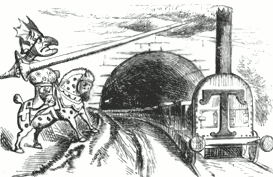Photographs by the author. You may use these without prior permission for any scholarly or educational purpose as long as you (1) credit the photographer and (2) link your document tto this URL, or cite it in a print one. The image of Hudson's family from the National Portrait Gallery, London, requires separate permission from the gallery. [Click on all the images to enlarge them.]

he story of George Hudson (1800-71) is told on three plaques and two boards in the city of York. There is no statue of him – though there is one of George Leeman (1809-1882) the Liberal MP for York, who opposed the building of Lendal Bridge as it would only serve Hudson’s railway interest (Hudson became MP for Sunderland). Curiously, Leeman’s statue was placed between the bridge and the railway station.


Left: Plaque at the National Trust shop in College Street. Right: The shop on the corner with Goodramgate.
George Hudson was born in 1800 in Howsham, a village about 12 miles from York. He was the fifth son of ten children of a tenant farmer. Needing to make a living, he took an apprenticeship at a linen-draper’s in York; married the owner’s sister, and in 1821 became a partner in the business.


Left: Holy Trinity Church, Goodramgate (Churches Conservation Trust). The towers of the Minster can be seen behind it. Right: The aisle and the altar.
George Hudson was married to Elizabeth Nicholson at this church (in area 11 of the parish map) in 1821. One of many medieval churches in the city, the church has never been restored and retains many old features, the most notable being the box pews visible in the photograph on the right above. The parish abuts the Minster's, but was so small it may not even have extended to the draper’s shop.


Left: The house at 44 Monkgate. Right: Plaque for Hudson outside no. 44.
In 1827, Hudson inherited money and this smart house on Monkgate from a great-uncle. He lived there till 1847, and bought adjacent nos. 40 and 42. The house had been built in the 1720s, but the interior was transformed for him by G. T. Andrews (Fawcett 27, 58, 226; Pevsner and Neave 247). The large pilastered door-case with side-lights was put in for him; the feature is described as a ‘tripartite entrance’ by Bill Fawcett.

Portrait of Hudson with his family, © National Portrait Gallery (acquisition no. 5886).
The portrait, 18 in. x 21 7/8 in. (463 mm x 556 mm), is composed of cut-out silhouettes against a watercolour background, and dated to c. 1837. Since Hudson wears robes and chains of office, it might have been made just after his first installation as Mayor of York. At any rate, it is most likely to have been painted inside this house. The gallery suggests that the silhouette artist might have been Samuel Thomas Gill or E.G.A. Norman, who were both associated with the Hubard Gallery, which produced portraits of this kind.


Left: Mayoral board in Holy Trinity, Goodramgate. [Close-up of Hudson's name.] Right: The Mayor's Pew box.
George Hudson was Lord Mayor of York three times, in 1838, 1839 and 1846. Other mayors would have had associations with other parishes, so there are only three names on this board. There is also a special pew centrally at the west end which is said to be for the Lord Mayor, with two lesser box-pews either side for churchwardens. Hudson was expelled from the City Council in 1849 after financial irregularities were exposed.

Plaque at the corner of George Hudson Street and Micklegate.
At the height of his fame, ‘Hudson Street’ had been named after him, it is close to the railway station of 1840. After his fall in 1849, the name was changed to Railway Street, and changed again in 1971 to the present name. Hudson’s business dealings in connection with railways were his downfall. From 1848, bank failures, reduced dividends and lack of new schemes, all exposed the weakness, and worse, of his financial arrangements. Losing parliamentary immunity in 1859, he thus became liable for imprisonment for debt, and he fled to France, remaining there for some years. He died in London in 1871, but is buried at Scrayingham.

Hudson Quarter: view looking ahead along the route of the track for the Scarborough platforms.
At the Hudson Quarter in York, seen from this vantage point, the Victorian brick wall on the left retains a grass bank up to the medieval stone walls; on the right is a glimpse of remnants of the 1840s trainshed over the main arrival and departure platforms, now a cycle-park. In the distance are seen, left to right, the cenotaph War Memorial; the tower of St Wilfrid’s built as the pro-cathedral for the Roman Catholic diocese of Beverley in 1862-4; one of the west towers of York Minster, and the former North Eastern Railway headquarters, built in 1906 and now a hotel.
Hudson’s schemes brought fame and employment to York, but his wider reputation has never quite recovered from his financial mis-dealings. In the late twentiethth century, a huge office building on the site of the 1840s railway station was called Hudson House; this belonged to the railway organisation of the day, British Rail. Its site is now redeveloped for housing, and the area is advertised as ‘Hudson Quarter’.
Links to Related Material
- The Growth of Victorian Railways
- Hudson the Railway King (with reference to Carlyle's "Hudson's Statue")
- "Hudson's Statue"
- King Hudson's Levée (cartoon in Punch)
Bibliography
Fawcett, Bill. George Townsend Andrews of York: “The Railway Architect”. York: YAYAS and North Eastern Railway Association, 2011, 45.
"George Hudson (1800 – 1871)." York Civic Trust. Web. 22 January 2023.
McKechnie, Sue. British Silhouette Artists and Their Work, 1760-1860. London: Philip Wilson for Sotheby Parke Bernet, 1978. 236-246.
Pevsner, Nikolaus, and David Neave. Yorkshire: York and the East Riding. New Haven and London: Yale University Press, 2002.
Created 22 January 2023